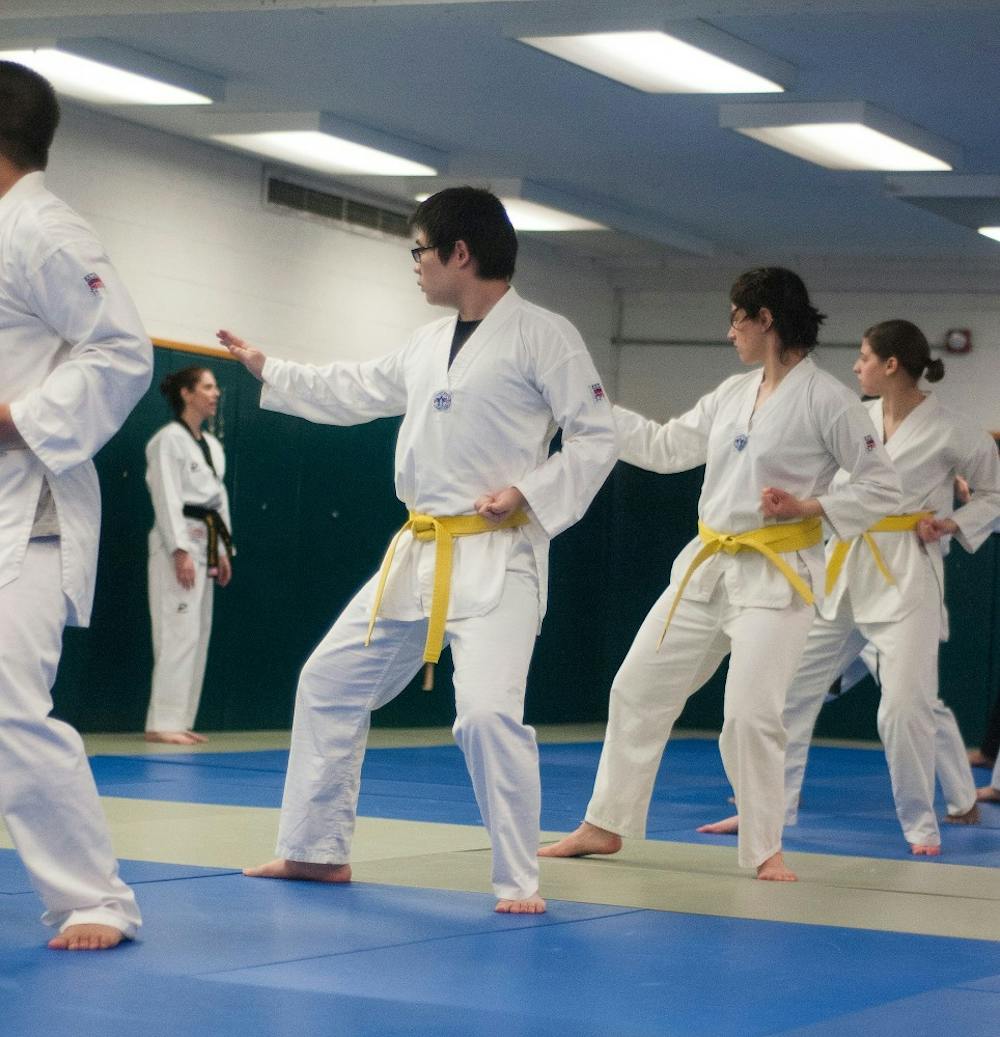After learning that his grandfather was one of the first generations to be a part of the varsity fencing team, physics junior Joseph Latham checked out what the organization was about for kicks when he first came to MSU in 2012.
Latham quickly got addicted to the intensity and latched on to the sport — he’s now the men’s captain.
Although fencing is no longer a varsity team, it has a firm place as a club sport with 45 team members.
What a lot of students don’t realize is that there are several options for competitive sports that go beyond being on a varsity team.
Varsity offers some athletes scholarships, giving them an incentive to stay on the team. On the other hand, intramural is low-cost fun. But club sports falls somewhere in between. And fencing, baseball and taekwondo are just a few of the many club sports that are available to students at MSU.
The difference between club sports and varsity is that students are paying out of their pockets to be involved with the team of their choosing.
“Club sports are passionate and (the students) are willing to take money and time out of their bank accounts and personal lives to invest in what they’re doing,” said Angela Michael, the assistant director for Recreational Sports and Fitness Services.
Forming a club sport isn’t simple either. Much effort goes into it from every angle.
In 2010 MSU Recreational Sports and Fitness Services re-evaluated all 52 club sports teams and only kept the 28 that are competitive and who would benefit from campus facilities.
Michael said club sports offer students the chance to explore something that they never have really gotten to do before.
“Who has experience with underwater hockey before coming to college?” Michael joked.
A great deal of effort
Latham and the rest of the fencing team put in two hours of practice four nights a week. That’s on top of traveling every other weekend to fence competitively for seven to nine hours.
“We’re not paid to be here — we could work more hours at a job, study harder. But we come here because we enjoy the sport and the people,” Latham said.
According to Greg Normand, the president of Women’s Collegiate Lacrosse Association and club coach, the time commitment required for club sports might be the same as varsity sports. It just depends on the sport.
The lacrosse team regularly competes against Division III collegiate teams in the fall, including Albion and Hope college, for a pre-season feel, Normand said.
Once spring season begins, the NCAA does not allow club and varsity teams to intermix. Normand said there are all-state high schoolers and students who transferred from these lower division schools who could play at the varsity level.
For these athletes, it’s purely heart and soul that drives their organizations.
Laura Cheaney, fencing president and biochemistry and molecular biology senior, said that for the fencing team there is strong competition for a spot on the travel team because there are limited places. But it’s different from varsity because there is no scholarship incentive.
“They’re here to have fun, learn how to fence and make friends,” Cheaney said.
Building leadership skills
For each of the 28 clubs, there is a student president, vice president, treasurer and secretary. Some have officers, web designers and fundraising chairs.
“If you’re a good club leader, when you’re done, you could run a small business,” Michael said.
A unique dynamic exists for club sports, where the athletes are in charge of the coaches.
About three-fourths of the teams have non-student coaches hired from around the community or alumni who participated during their college years.
“Most coaches are fired from club teams, not because they’re bad coaches, but because they pissed off somebody,” Normand said.
It’s a decision the athletes get to make. If they don’t like how the team is being run, they will address the situation and have the option of firing the coach.
“Club leaders get a very different experience than an intercollegiate athlete because they get to see the inner workings,” Michael said. “I don’t feel bad for the clubs because they have to work so hard because I think it just builds character and it makes them better (people) because of it.”
Latham handles problem and conflict management for the fencing team.
“When you get opportunities like this in college, it’s infinitely useful in the workplace,” he said.
Those who hold these leadership positions learn to manage their time, handle planning and traveling and how to coordinate and participate in practices.
Men’s volleyball captain and criminal justice senior Scott Benedickson said this is the most important skill he has learned through club sports.
“Whatever career or field we go into, we can take control because we have that experience leading a team of 12 people,” he said.
For all that goes into participating and running a club sport, athletes need to be “dedicated” individuals, Cheaney said.
Raising the funds
To sustain their organizations, club teams raise all of the funds needed to cover facility dues, travel costs, new equipment purchases, tournament dues and coaches. Budgets and finances are entirely maintained by the individual teams.
The women’s lacrosse team recently returned from Santa Barbara, California, from a shootout tournament which was planned on a $35,000 budget.
Teams often hold annual events as their main method of fundraising.
Men’s and women’s volleyball host an annual tournament and use the money from tickets, concessions and donations to reduce their dues, which is $350 a semester.
Fencing hosts an alumni tournament, during which they welcome back all members who were a part of the group — including those involved when it was a varsity sport.
“We beg for money basically,” Latham said.
Teams are encouraged by Michael to consider endowments to help with future funding.
When committing to this, teams get five years to raise $50,000. Afterward, they are able to have a stable income from the interest of the investment. This allows the team to be prepared for future expenses. Men’s lacrosse, men’s soccer and crew are the only club sports who currently have endowments.
“We play in a very competitive league (MCLA), and we play a very tough schedule,” men’s lacrosse head coach Brandon Schwind said.
Because of endowment and fundraising efforts, the men’s lacrosse team is able to take trips to multiple states including Arizona, California, Virginia, Pennsylvania and Indiana to play “some of the best teams in the MCLA,” Schwind said.
But Latham wouldn’t trade the whole experience for anything.
“It does take up a substantial amount of time and money, but I’d say it’s worth it,” Latham said.







